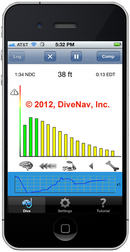I know the concepts, but I can't see the math and the progression of how it affects my dive was my point.actually .... most of them are not anymore.
3 simple concepts: compartments, overpressure gradients and half times.
Here you go
Alberto (aka eDiver)
The training course I mentioned in my first post still implies most computers use the tables as a basis for their algorithms. If that's not the case I guess I'm not the only one who "Knows" something incorrect.
Thanks for the link. I suspect that will help clarify things a bit.





